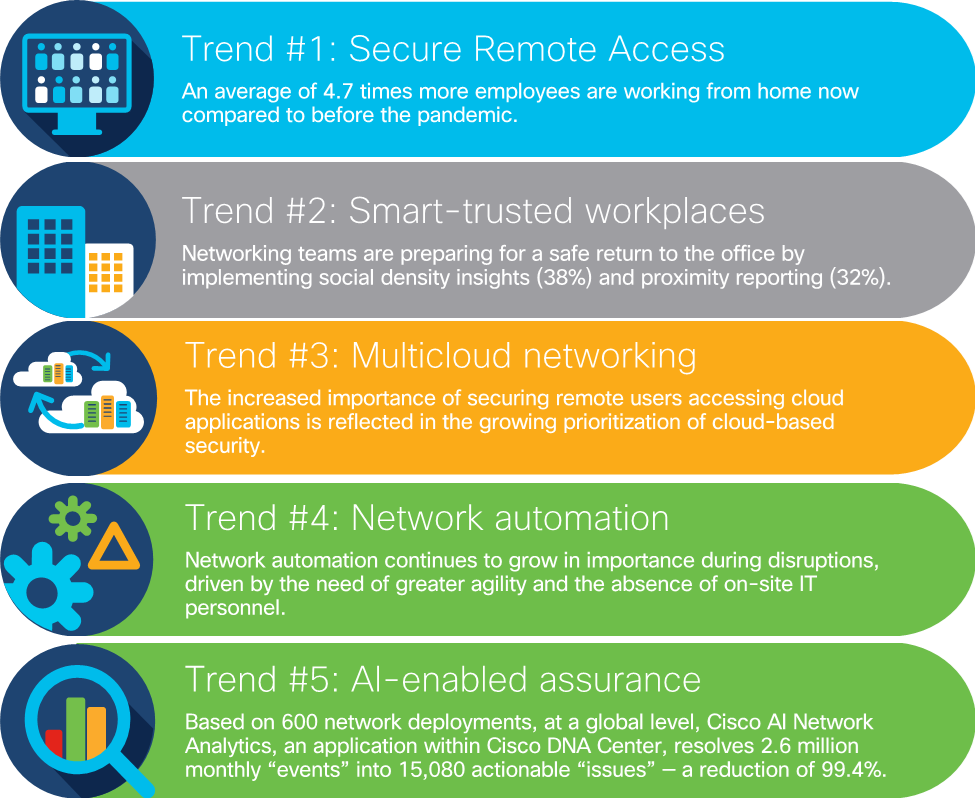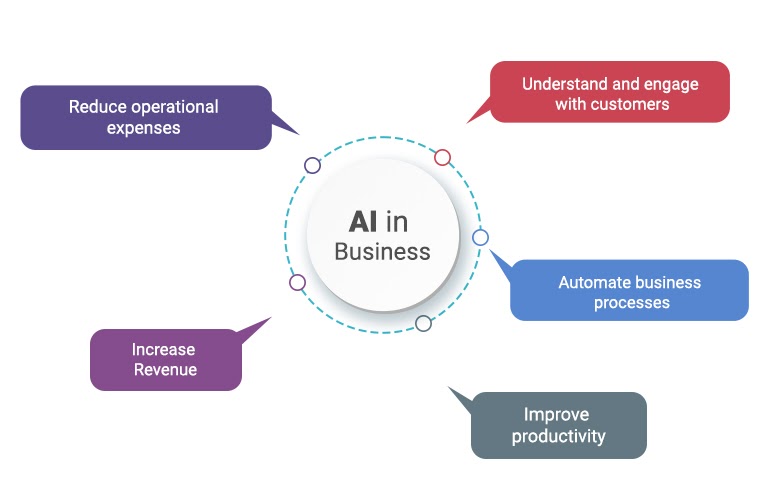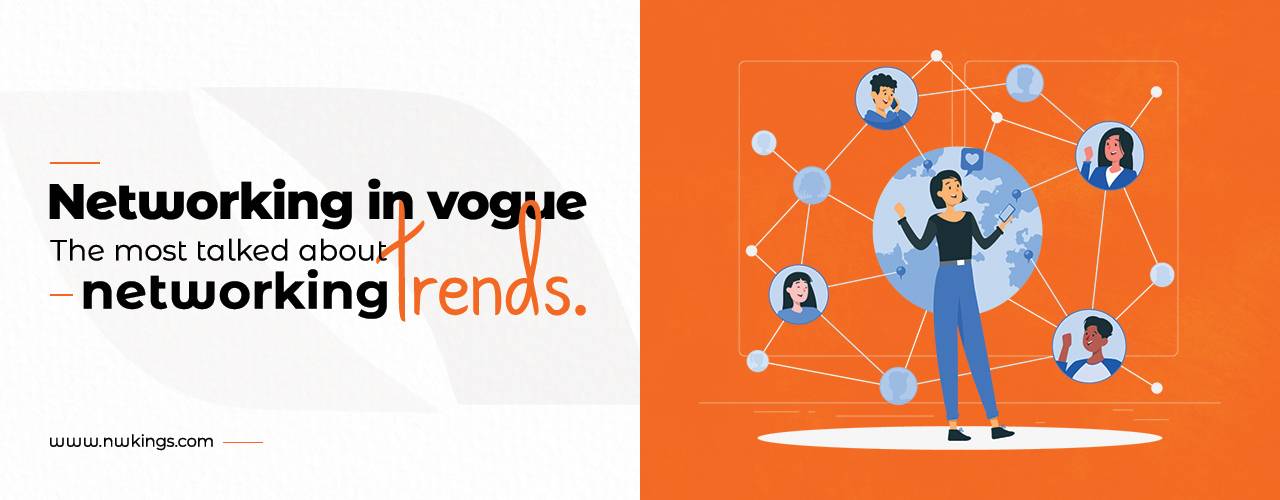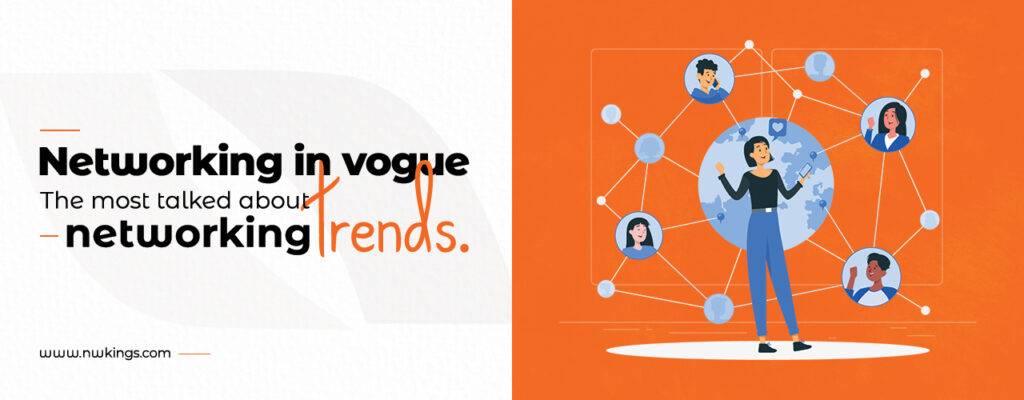
Keeping up to date with the most recent Networking Trends has become more important than ever as networking technologies are constantly advancing. This evolution of networks makes it easier for us to remain digitally connected, opening a world of possibilities both in terms of business and individual prospects. Web Technology allows information to be shared rapidly across online portals while Online Sharing connects people from all parts of the globe. With so many new opportunities we must stay informed about these trends if we want our businesses to flourish by making use of digital connectivity or even just keep pace with others!
Explanation of Networking Trends for Beginners

Networking trends do not stand still; they are ever-evolving and advancing at a rapid pace. It is tricky for beginners starting out or even those of us who have been in the networking game for a while to keep up with it all. To make things easier let us take a look at some popular global networking trends we should be aware of – like virtualization which has become increasingly popular across various industries lately.
Virtualisation provides businesses with the ability to host their applications and databases on distant servers, rather than having them run on separate machines. This helps organisations access information from any part of the world quickly and efficiently scale up their infrastructure. It also aids in cutting down hardware costs by allowing companies to share resources amongst many users concurrently.
A modern development within network technology is software-defined networking (SDN). SDN offers network administrators a way of configuring networks via independent software not depending upon underlying physical components – making it easier for IT departments to modify present operations or manage certain new ones without needing additional equipment purchase or reconfiguration work around existing hardware devices.
Networking has become more flexible and reliable of late, thanks to the fact that changes do not require physical equipment reconfigurations or replacements. Administrators can also provision bandwidth dynamically based on need rather than availability or budget constraints – a huge improvement compared to how it was before.
Cloud computing, the Internet of Things (IoT) and 5G wireless technology are some other major trends which have revolutionised network performance in terms of speediness and efficiency. Cloud computing lets businesses store data offsite as well as manage applications remotely while IoT enables improved conversation between connected devices plus real-time data analysis providing valuable insights into user behaviours and preferences. Last but not least is 5G; offering enhanced mobile broadband speeds with significantly lower latency when pitted against 4G networks.
Overall these networking trends offer many perks however one should carefully consider each option before committing fully so they don’t end up wasting resources if another solution could prove better for long-term gains!
Key Factors Driving Network Evolution
We are in the midst of a digital era and network evolution is quickening more than ever. Cloud-based services and Software Defined Networking (SDN) have certainly changed up our networks, but what’s causing this transformation?
The primary motivator for revolutionising networks has been enhanced technology as well as new ventures into networking abilities. With hardware becoming stronger and data processing speeds augmenting at an accelerated rate, it opens doors to building greater usefulness within networks so they can better back up apps and services. But how do we make use of these developing tools?
Furthermore, advances in wireless technology have allowed devices to link up faster and more securely. This has not only improved the capability of cellular gadgets but also opened the way for remote access. Plus, high-speed broadband Internet connections have had a big hand in moving along network development too. Companies can now send heaps of data quickly via various networks with higher download and upload speeds available at their disposal – thanks to fibre optic cables that greatly reduce latency even over long distances; making it possible for real-time conversations between people across wide areas.
User needs are evolving all the time, pushing for faster response times and greater reliability in networks. To keep up with these demands, organisations have turned to edge computing – getting computing power closer to users so they can use applications or services on their network infrastructure without worrying about latency issues. This has resulted in new security systems being developed too; distributed denial-of-service (DDoS) attacks protect against cyber threats targeting not only the network but also any user connected to it. How do you make sure your data is safe?
Ultimately, virtualisation technology has been a huge boon for the development of networks by allowing multiple virtual machines or instances to share physical resources such as memory, storage space and computing power without compromising on performance or security levels. This is incredibly advantageous when it comes to cloud-based services which require them to be able to scale up easily according to demand with no extra cost nor any surplus complexity stemming from dedicated servers or hardware updates.
All these factors combined have paved the way for accelerated expansion in the networking industry leading us towards new products, facilities and solutions that are empowering organisations to capitalise on promising opportunities presented by this ever-changing environment.
Understanding the importance of Digital Connectivity

In the digital world we live in nowadays, having strong digital connectivity is becoming more and more of a must. As companies and individuals move ever further into the online realm, they need to have reliable, rapid connections if they want to stay ahead of the competition. To do well in this continuously evolving technological landscape it is essential that you get how significant good internet access is.
More fundamentally speaking, being able to go online has become crucial as by doing so people can access data and materials which just would not be available without an internet connection – think about all those opportunities you’d miss out on!
Businesses need data to make sound decisions, and their staff require access to the most recent software or systems. What’s more, high-speed connections give employees an advantage when it comes to optimal productivity – they can swiftly transfer large documents (upload/download). And not just that; faster speeds permit streaming live video content from any corner of the world without lags.
On top of this individuals benefit from modern communication tools such as Skype and Zoom which let them communicate with coworkers far away while keeping no requirement for actual presence in one place.
These days, technology can save tonnes of money on travel expenses and time that would usually be taken up by getting ready for a meeting or traipsing between locations. What’s more, digital tech has opened the doors to new markets and opportunities for entrepreneurs who have been able to jump into global markets with both feet thanks to tools like Shopify or AWS (Amazon Web Services).
These amazing platforms offer accesses which used to only come at an expensive rate if you wanted them offline. Even better is that being connected means entrepreneurs are in a perfect position not just to reach out to customers but also to promote their products digitally using techniques such as social media marketing campaigns and website optimization tactics.
Getting clued up about how important it is to stay current with all things digital could make a real difference when navigating today’s increasingly switched-on atmosphere. Both business people and individuals need to invest in dependable connections if they are looking forward to long-term success in this ever-developing technological world.
Latest advancements in Web Technology

The Internet is growing at a crazy speed, and web technology isn’t lagging. It’s taken the internet to new heights – nowadays websites are very interactive and make navigating them so much easier. Web developers have some useful tools such as JavaScript, HTML5 or CSS3 that help create stunning sites with all sorts of great features. On top of this, they can use newer techniques like Angular JS, ReactJS or Node.js to create even more powerful apps providing users with an awesome experience!
Likewise, fresh designs are being rolled out for better access to content which also makes websites load faster. Given these improvements, networking trends have been transformed markedly in recent years. The current emphasis is on fabricating systems and networks that can process huge volumes of data traffic effectively without sacrificing speed or performance. Cloud computing has turned into a popular solution for storing and managing an abundance of data securely without necessitating physical hardware or intricate IT infrastructure.
This type of network enables organisations to store their information online instead of locally while furnishing scalability plus enhanced security features that regional networks couldn’t supply before now. Advanced technologies such as software-defined networking (SDN) make it possible for companies to optimise their networks by dynamically controlling routing paths dependent on application requirements plus the amount of traffic there is at any given time – eliminating manual settings changes needed to enhance its functioning making it more efficient overall plus cost effective long term too!
Implication of Online Sharing on Networking

No doubt, the last decade has seen a massive shift in how networking works. We’re now seeing more of our connections being made online rather than face-to-face – with social media platforms, messaging services and web technologies all playing a role in how we chat and build relationships. But what does this mean for us when it comes to making those important contacts? How have these digital mediums affected our ability to network effectively?
The answer is clear: Online sharing has had an enormous impact on our chances of successful networking. It’s opened up new opportunities; you can reach far more people from across the world by joining relevant online groups or leveraging your network of shared interests through sites like LinkedIn.
Plus there are other advantages too – with many industry events now available virtually via video conferencing apps such as Zoom, allowing greater access regardless of geographical location or time zone restrictions! The range of possibilities that open up thanks to digital communication tools is huge – so why not take advantage?
Before the internet was widespread, networking meant going to real events or social gatherings to build up your contacts list. Nowadays, however, you can sign up for online communities or join different groups on social media which are focused on certain interests and locations. This presents us with a chance to reach out far beyond our imaginations without ever having to step outside our comfort zone; it’s become easier than ever before to create meaningful connections and form personal networks with those who share similar views from all across the globe!
It’s wild how much technology has allowed us to bridge distances that would have been too hard or impossible just a couple of decades ago – imagine being able to connect yourself so quickly with somebody thousands of miles away. The possibilities truly seem endless now when it comes to things like this!
Online sharing also helps us keep up with our existing contacts more regularly than before; messaging platforms let us connect with people quickly instead of waiting for days to get a response by post or email. By making it easier to chat between ourselves and the folks in our networks, we can take care of those relationships better – something that’s crucial when it comes to constructing powerful connections which could assist us professionally or socially.
What’s more, through online sharing we have access to novel features such as digital CVs which allow us to showcase professional info about ourselves in an easy-to-read format, reaching out to potential employers or recruiters who might be looking for applicants possessing some particular abilities and knowledge. With clever algorithms like search engine optimization (SEO) helping make sure that our electronic CV come top on results pages when possible bosses type searches related to what we offer – just another way online interaction is aiding open doors even further for networking prospects!
The role of AI in shaping Networking Trends

Exploring the role of Artificial Intelligence (AI) in shaping Networking Trends is an intriguing concept. AI has been front and centre when it comes to making advances within this domain, where many companies are utilising its capacity for automating processes as well as gaining deeper insights into their networks.
Utilisation of AI can help streamline networking procedures by providing users with a more efficient way to manage their connections, whilst predictive analytics comes into play which then aids decision-making strategies. For instance, employing AI-powered network analysis tools enables us to detect any abnormal behaviour regarding our network traffic and alert administrators if there happens to be potential security threats on the horizon.
What’s so impressive about AI is its ability to provide more intelligent recommendations for optimising user experience and bandwidth utilisation. But that’s not all; these incredible technologies also have massive implications when it comes to facilitating smart devices on a network. Thanks to this, the latency of communication between items gets cut dramatically, improving performance massively – enabling networks to scale up quicker while being able to handle high volumes of data from multiple sources in much less time.
Moreover, using machine learning algorithms that develop over time, these devices become increasingly intelligent in the way they process data and make better decisions about their environment. Particularly noteworthy is the predictive capacity Artificial Intelligence brings to networking trends. With AI-driven deep learning techniques, any device linked to a given network can analyse past inputs of information and give useful forecasts regarding outcomes or patterns occurring on the system itself.
This allows businesses to anticipate possible changes or events before they take place – allowing them an active method for maximising efficiency while reducing surprise expenses from unexpected scenarios which might pop up later down the line.
How Network Evolution Has Impacted Businesses?

The ever-evolving tech landscape has been rapidly revolutionising how businesses operate. Network evolution is arguably the most crucial element of this shift, with organisations from all corners of the world embracing cutting-edge technology to meet their networking requirements – so what effect has network evolution had on business operations?
Well, faster and more reliable communication within a company will be one of many direct results brought about by network transformation.
Ethernet cables have had a huge impact on data transfer speeds for local networking, giving businesses the chance to remain connected with their customers, partners and suppliers even if they’re in different parts of the globe.
This increased speed has been hugely beneficial to companies when it comes to providing better customer service as well as streamlining internal operations management – not forgetting reduced costs such as no need for travelling between offices situated far away from each other. What’s more, now we are beginning to see progress towards cloud-based solutions which allow organisations to move away from traditional hardware infrastructures that tend to be pricey when it comes to maintaining them and making regular updates.
What does the ever-evolving world of networking mean for businesses? Network evolution has had a profound impact on companies, providing numerous benefits from more secure connections to faster communication and cost-effective solutions.
For larger corporations who have made investments into their infrastructure, products like Wi-Fi hotspots or remote access gateway systems ensure they can reap all the rewards without needing to keep investing in expensive hardware. Smaller organisations also benefit thanks to these customised alternatives which are designed specifically with them in mind – it means even if you don’t have major resources behind you yet still need efficient networking capabilities within your business; there is an option available for you too!
Protocols such as IPsec and SSL/TLS make data exchange much safer than before so those firms dealing with sensitive customer information no longer need to worry about external threats disrupting company networks or information systems – knowing this provides peace of mind that everything is kept safe at all times.
Ultimately, we’re seeing how advantageous network evolution is across industries offering up multiple advantages including increased speed and security but not forgetting cost effectiveness when needed! What would our lives be like without these advancements?!
The Transformation of Web Technology in Recent Years
Nowadays, web technology has moved on from just static web pages and become an exciting interactive network with plenty of new possibilities. This progression in Web Technology is presenting businesses and people alike with the opportunity to use its effective characteristics for producing revolutionary applications. The expansion of this type of technology over recent years is mainly down to how cloud computing has come alive.
This has enabled firms to store a large number of data in the cloud and access it from any corner of the world whenever they wish. This simplifies sharing information as well as teaming up with other companies without having to worry about physical distance or hardware constraints.
Moreover, this type of technology can also be used for remote collaboration which enables people situated at different places to collaborate on projects together effortlessly. Web technologies have become popular among corporations seeking new marketing approaches such as search engine optimization (SEO). Have you ever thought about how SEOs boost website visitors?
Search Engine Optimisation (SEO) is a great way for websites to increase their visibility and presence online. When used effectively, SEO can help sites raise Google’s page rankings, making them easier to find when people search on the web. Companies are increasingly turning towards this strategy as it is an effective tool for increasing website traffic and conversions.
The use of mobile technology has also had a big impact on how we access internet content today. With smartphones becoming ever more popular, users now have greater freedom over where they view material – no matter where they are or what device they are using!
With the surge in web technology over recent years, businesses across multiple industries that highly rely on digital interaction with customers or other stakeholders have been greatly impacted. Not only do these advancements make processes more efficient but also opens up new avenues – enabling organisations from all around the world to gain valuable knowledge into how their customer behaves while giving them a great user experience which essentially helps foster strong relations between companies and consumers.
This makes it necessary for firms to switch up their strategies accordingly to ensure that they can content can be accessed regardless of what device or platform is used – including laptops, phones tablets etc. Furthermore, now that mobile tech has boomed there’s an even greater need for companies’ websites or pages to be optimized for use on mobiles otherwise potential buyers may opt out if this isn’t available causing precious leads to be lost!
Predicted Networking Trends for the Future

One of the trends being discussed in IT circles is the speculation over future networking advances. Many forecasted changes could potentially alter how networks function, but some seem more likely than others to take off and have a real impact. One such anticipated development is cloud-based solutions becoming increasingly popular – they offer greater access for remote sites and better security settings which help protect data from cyberattacks. This means businesses can feel safe in the knowledge their vital information will be protected by having these robust procedures put into place. So it’s no wonder there’s so much interest in this area!
What’s got people talking recently is the growth of cloud solutions which can offer improved scalability and flexibility for businesses as well as their clients. On top of that, 5G technology has caused a lot of buzz lately too. Offering speeds up to 100 times speedier than regular 4G networks, this new tech could open us up to more opportunities in terms of augmented reality, artificial intelligence and big data analytics – all over the world! This leaves us with some pretty exciting possibilities on what we will be able to do next when it comes to connectivity.
Recently, edge computing has been rising in popularity. This type of technology allows data processing to be done closer to the source rather than sending it back and forth between central locations and endpoints. Not only does this reduce latency but also creates a secure working environment compared with cloud deployments – it gives more flexibility for businesses too as they do not have to depend on one single cloud provider; providing there is an edge device connected to their network infrastructure then everything should work perfectly!
Moreover, the possibilities that arise from using edge computing are vast – we could explore opportunities such as connected cars or smart cities by allowing for connection requirements needed in these scenarios. All-in-all, its development shows no signs of slowing down anytime soon!
The Influence of Online Sharing on Web Technology
The arrival of the Internet revolutionised how we communicate and spread information. Advances in technology have increased our ability to access, interact with and share data more quickly. Over recent years online sharing has become increasingly popular because it allows us to connect with wider groups of people, showcase our work and get our ideas across faster than ever before – this trend has had a great impact on web development.
Varieties of online-sharing platforms such as social networking sites, blogs, video-hosting websites or e-commerce stores make communication simpler than it has ever been!
These days, online platforms have opened up the opportunity for us to get in contact with bigger audiences and exchange our thoughts; a move that fosters creativity and innovation across the web. Examples of this include voice assistants like Amazon Alexa which are inspired by sites such as Twitter – these applications let people interact using natural language processing (NLP).
It’s clear to see how closely intertwined modern internet technology is with trends surrounding sharing on social media – if we want better access speeds then there needs to be advanced infrastructure developments so everyone can stay connected securely. Moreover, technologies including augmented reality or AI require robust networks that provide uninterrupted services at decent speed levels – it’s indisputable that online sharing helps propel advances in web tech-forward! This hits home just how important open communication via various channels is when it comes to creating efficient future-proof systems.
Wrapping Up!
In conclusion, the networking world is in a continual state of flux and it’s critical to keep on top of upcoming trends. Network Evolution, Digital Connectivity, Web Technology and Online Sharing are all key areas that will shape how businesses run in the future. To stay ahead in this fast-moving digital arena we have today, companies must ensure they’re up-to-date with network technology advancements. How might embracing these technologies help your business grow? What opportunities can you find by staying current with emerging tech developments?
If you are keen on becoming a network engineer and building up your career, why not give our Network Engineer Master Program a try? Our program has been tailored with the latest technologies to make sure that by the end of it, you have all the qualifications necessary to become an authoritative figure in this field.
With us, you will get real-world case studies for practical experience, talks from top industry figures as well as hands-on training under expert guidance! We’ve also taken into consideration every aspect of networking so that upon completion you won’t just cover bottlenecks but rather know everything about enterprise applications too. So what are waiting for? Enroll today and start making progress towards achieving your dream job!
Happy Learning!




